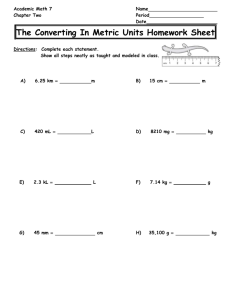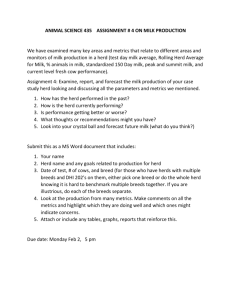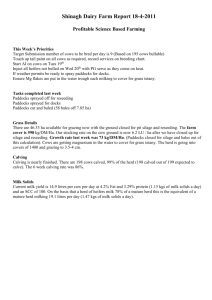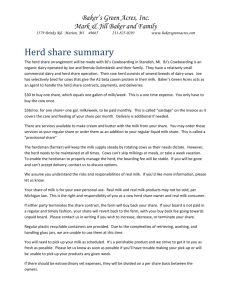Herd Record Keeping EXTENSION SERVIC OREGON AGRICULTURAL- COLLEGE
advertisement
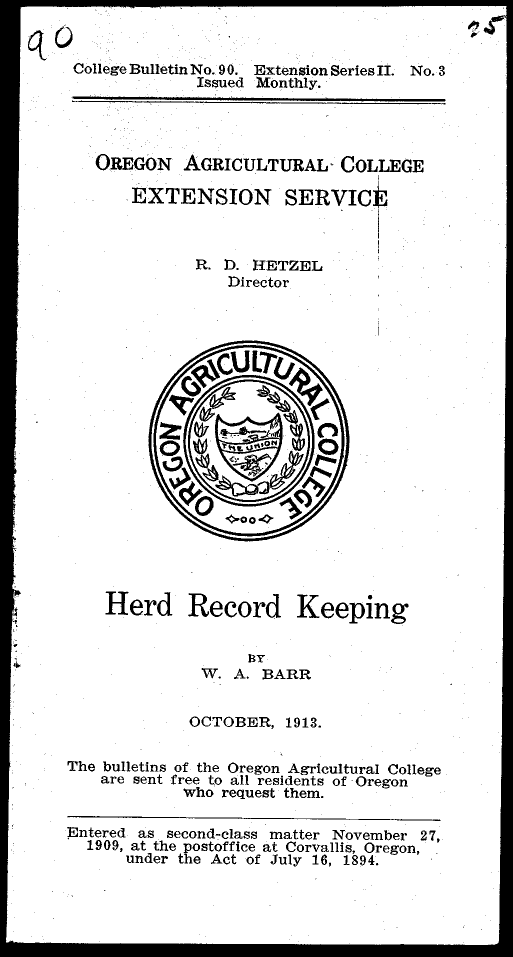
College Bulletin No. 90. Extension Series II. No. 3 Issued Monthly. OREGON AGRICULTURAL- COLLEGE EXTENSION SERVIC Herd Record Keeping BY W. A. BARR OCTOBER, 1913. The bulletins of the Oregon Agricultural College are sent free to all residents of Oregon Who request them. Entered as second-class matter November 27, 1909, at the postoff ice at Corvallis, Oregon, under the Act of July 16, 1894. SALEM, OREGON : STATE PRINTING DEPARTMENT 1913 RECORD HERD KEEPING 3 PREFATORY NOTE The work outlined by Mr. Barr in this leaflet is worthy of the most careful consideration by every educator and parent. It represents a definite and concrete method of vitalizing the work of our rural schools by teaching our boys and girls in terms that are real. It links the interests of the home and the school to the advantage of both. It makes the school an evident factor in community progress. It represents a step in the direction of better education and better rural life. The work has already been introduced in the rural schools of Polk County, and the Agricultural College is ready to aid in establishing it in other counties. The plan is outlined in the form of a contest, with the suggestion that suitable awards be offered for the best work done by the pupils. It is not essential to the success of the plan, however, that the contest feature be retained. Merit may be recognized by grades as in other school work. The State Superintendent has cooperated in introducing the work in Polk County. RALPH D. HETZEL. 4 OREGON AGRICULTURAL COLLEGE APPARATUS FOR EACH SCHOOL IN WHICH BABCOCK TESTERS ARE INSTALLED One Babcock Tester, (12-bottle tester preferable). One and one-half dozen whole milk test bottles. One-half dozen skim milk test bottles. Three acid measures. Three pipettes. Two pair dividers. One 16-ounce graduated acid measure. One box preservative tablets, (corrosive sublimate). Sulphuric acid in 1-gallon or 2-gallon amounts in jugs. Two dozen (or more if needed) composite sample jars. Bottles to be given each contestant corresponding to the number of cows on record. Approximate retail cost of apparatus, $18.00. RECORD HERD KEEPING RULES AND INSTRUCTIONS TO GOVERN HERD RECORDKEEPING CONTEST IN PUBLIC SCHOOLS RULES 1. This contest is open to all pupils attending the schools of a given county, in which such a contest shall be instituted, who are classified in or above the seventh grade; boys over fourteen years of age who may be below the seventh grade are also eligible to enter the contest. 2. Each contestant shall keep in the manner prescribed a record for one year upon not less than three cows nor more than twelve. None of the cows selected by one contestant shall be included in the record of another contestant. In case one of the cows is eliminated from the herd she shall be replaced by another, but otherwise no change shall be made from the cows with which the record is begun. 3. Those eligible to the contest whose parents do not conduct dairies, may, upon the consent of the owner of a dairy herd, keep and submit as contestants a record upon such herd. 4. The contestants will not be ranked according to amount of production of the herd under record, but upon the manner in which the record is kept. The following scale of points will be used in grading: Completeness of record 30 Accuracy, of record 20 Neatness of record 10 Essay on record 40 Total for perfect 100 6 OREGON AGRICULTURAL COLLEGE 5. Properly to equalize the difference in the age and maturity of contestants, the following handicap is provided: Seven points will be added to the judges' grade of each seventh grade contestant (or below the seventh and over fourteen years of age); four points will be added to the judges' grade of each eighth grade contestant; five points will be added to the judges' grade of each contestant who shall keep a record on eight or more cows up to or including the maximum number (12). 6. No entrance fee or other fee will be charged. 7. Each herd under record will be given a number, in order that any reference made to the work of a certain herd will not disclose the identity of the owner. 8. Each record shall consist of the amount of milk and butterfat production of each cow entered, with the value of the same; the amount and value of feed consumed; and the net profit of each cow, together with dates of freshening, drying, and age of each cow. 9. Morning and night milk from each cow shall be weighed and a sample taken on the 5th, 15th and 25th of each month, and the average of these daily weights shall be used in computing the monthly milk production of each cow. 10. The samples taken shall be preserved and the composite sample shall be tested after the third monthly sample has been added to the composite sample. 11. The feed consumed by each cow shall be weighed on the 15th of each month and at other times when a change in the amount or kind of feed is made, and the value shall be computed on the basis of the market value. When cows consume hay or other roughage from a common rack, the amount for each cow RECORD HERD KEEPING Pasture shall be shall be estimated. valued at the prevailing commercial rate. 12. Necessary absence from school or inability to take milk weights at a given time will not affect a contestant's grade, provided the weights of milk and feed are made by those in charge of the herd. Testing of samples and all computations must be performed by the contestant. WEIGHING AND SAMPLING MILK The dates mentioned in the rules (5th, 15th and 25th of each month) should be followed as closely as possible. If, at a given time, however, it is of especial advantage to take weights and samples a day earlier or later, it should be indicated on the stable sheet. An extra bucket not used for milking should be left at the scales, and each cow's milk, after being weighed, should be poured into this bucket. The act of pouring will mix the milk sufficiently for sampling. One small dipperful should then be taken and placed in a sample bottle bearing the name or number of the cow, there being a sample bottle for each cow under record. On the first day for taking samples, a preservative tablet should be placed in each bottle to prevent the spoiling of the milk, as there will be six samples in each bottle at testing time, the first having been in the bottle since the fifth of the month. The tops of the bottles should be kept tightly screwed down to prevent evaporation. They must be kept in a cool place, but not allowed to freeze. In transferring samples to school for testing, care should be taken not to shake the bottles unnecessarily, as this will cause particles of butter- 8 OREGON AGRICULTURAL COLLEGE fat to gather which cannot be easily mixed again before testing. The time of testing shall be arranged by the teacher, under whose supervision the test shall be made. During vacation, the test will be supervised by some one designated for the work. DIRECTIONS FOR MAKING TESTS Warm the samples in water at about 90 degrees F. for a few minutes, then mix, by pouring from the sample bottle to another bottle, until the milk is a uniform mixture and all cream particles have been dissolved. MEASURING THE SAMPLE This is done with a pipette which holds, up to the mark on the stem, 17.6 c. c. The milk is sucked up into the pipette and the finger quickly placed over the upper end of the pipette to keep the milk from running out. This done, place the point of the pipette in the mouth of the test bottle, holding both in an inclined position to allow the milk to run down the side of the neck of the test bottle, thus allowing an exit for the air in the bottle. If this precaution is not taken, the air will bubble out and cause the milk to overflow. Allow the pipette to drain into the test bottle, blowing into the end to discharge the last drop of milk. ADDING THE ACID Cool the samples in water at about 60 degrees F., then add 17.5 c. c. sulphuric acid, the amount indicated by the mark on the acid measure. It sometimes happens that the acid is too strong, resulting in a dark colored test with spots in the fat column. When this occurs, reduce the RECORD HERD KEEPING amount of acid. A milky fat column indicates too little or too weak acid, when more should be used. The milk and the acid should then be mixed by giving the bottle a rotary motion. The liquid will then be dark brown in color and of a high temperature due to the chemical action on the milk of the acid, which dissolves all of the solids except the fat, which is left in suspension in the liquid. Care should be taken not to get the acid on the clothing or upon the person, as it is very corrosive; but should this occur, wash off the acid quickly with water. Color can be restored to clothing by treating the spots with ammonia water. WHIRLING THE BOTTLES Place the test bottles in the tester and whirl for five minutes. Then stop the machine and add water at 130 to 140 degrees, filling the bottles to the base of the neck. Then whirl the bottles one minute, and add water to bring the fat column well up into the neck of the bottle. Whirl again for one minute, then remove the bottles from the tester and read the tests by using a pair of dividers, placing one point so that it marks the lower part of the fat column and the other point the upper line of the fat column. Without permitting the dividers to open or close, place one point at zero; the upper point will then indicate upon the graduated neck of the test bottle the figure that represents the test of the milk. Each mark between the numbers represents one-tenth of one per cent. While emptying the bottles, shake vigorously to remove the white precipitate which will settle in the bottom of the bottle. The bottles should then be washed, with the aid of washing powder, and rinsed with clear hot water. 10 OREGON AGRICULTURAL COLLEGE COMPUTATIONS After the tests have been made, the computations and posting can be done. Let us assume the barn sheet shows the following weights: FOR ONE COW 5th—A. P. 15th—A. P. 25th—A. P. Total MILK M., 12.0 M., 14.5 M., 11.5 M., 12.5 M., 12.0 M., 12.0 pounds. pounds. pounds. pounds. pounds. pounds. 74.5 pounds. FEED (Weighed on 15th of the month) 6 pounds mixed grain daily. 15 pounds hay daily. 30 pounds kale or silage. The milk total in pounds, 74.5, divided by 3, gives the average daily amount of milk produced. This, multiplied by 31, (number of days in a month), gives the amount of milk produced in a month, which is 768.8 pounds. If the butterfat test was 3.8 per cent, the amount of butterfat would be 769 times .038, which is 29.222 pounds. Considering butterfat worth 31 cents per pound, the value of 29.222 pounds would be $9.05. Valuing the skim milk at 40 cents per hundred pounds, gives $2.67 additional, or a total of $11.72. Multiplying each amount of feed by 31 gives 186 pounds of grain, which, if worth $25.00 per ton, would cost $2.321/2. The hay in the same way, at $8.00 per ton, $1.86. The kale or silage at $4.00, $1.86, making a total of $6.04 feed cost for the RECORD HERD KEEPING 11 month. Taus, $11.72, minus $6.04, equals $5.68, the profit for the month. SUGGESTIONS TO CONTESTANTS Enter each cow upon which the record for the year will be kept, in alphabetical order in the record book, at the time of beginning the record, whether the cow is giving milk or not. A record of the feed must be kept while the cow is dry as well vps while giving milk. Where butter is made, or where cream is sold, give the skim milk a valuation as follows: 31, times the amount of butterfat will give the amount of cream; this taken from the amount of whole milk gives the amount of skim milk, which at 40 cents per hundred will give the worth for farm use. Carry out all totals for each month and complete "Herd Summary" at the close of the year. Remember that neatness costs nothing and will add greatly to the appearance of your work. The essay to be submitted must contain not less than 700 words nor more than 850 words, and must show original preparation. It may include or be based upon the performance of the herd for the year; may contain comparisons of the work and efficiency of two cows in the herd; a comparison of the results of one month's feeding with any other month of the year; outline of plans or suggestions for building up the herd; the betterment of sanitary conditions around the dairy, or anything pertaining to the work in hand for the year.


